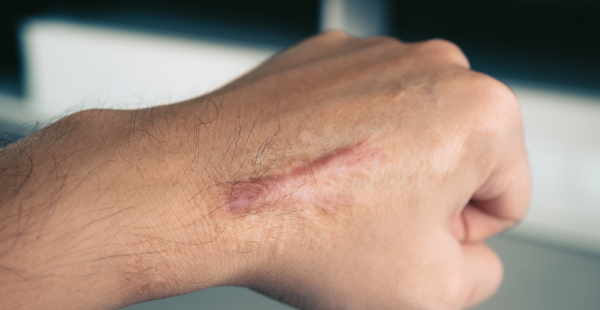Keloids are benign (noncancerous), fibrous skin tumours. They are most common in people with darker skin (e.g., people from West Africa or Southern India). People usually develop them between the ages of 10 and 30. Men and women are equally likely to have keloids. Keloids may also run in families.

Keloids usually occur at the site of skin damage (e.g., acne, burns, chicken pox, cuts, insect bites, piercings, surgery, tattoos, vaccinations), although they can occur spontaneously. Whether or not a keloid will form is not determined by the severity of the wound – even a minor skin abrasion can result in keloid formation.
Keloids are the result of abnormal wound healing. Normally, there is a balance between the production and the breakdown of collagen, which is a protein that makes up the fibres in the skin. With keloidal scars, the cells in the skin called fibroblasts produce excessive amounts of collagen. The collagen fibres are also thicker and wavier. This leads to the thick, raised appearance that is characteristic of keloidal scars. It is unclear what prompts this unusual healing process. Possible causes include genetic factors, skin tension, and the presence of a very high number of fibroblasts in the skin.
Currently, there is no completely effective way to treat keloids or to prevent their formation. Traditionally, surgical removal of the scars was recommended. However, 45% to 100% of people will have a recurrence of the scar if surgery is not combined with other treatment (e.g., radiation, pressure dressings), and the new scar can actually be larger and more prominent than the original scar.
A mainstay for both treatment and prevention is the injection of steroids such as triamcinolone directly into the scar. Steroids help prevent inflammation and promote the breakdown of collagen. This helps to make scars less raised, and to decrease pain and tenderness associated with the scar.
Laser therapy is now used to treat many types of skin problems, including keloids. It is often combined with steroid injections to give the best cosmetic result.
Silicon gel dressings are a popular alternative to steroid injections, although there is only limited evidence suggesting the dressings are effective in preventing abnormal scarring in people who are at high risk of developing keloids. Other treatment options include radiation therapy and medications such as interferon*, 5-fluorouracil, imiquimod, and bleomycin.
If you have a history of forming keloids and are having surgery, discuss with your surgeon any strategies to prevent keloid formation. Also, those with a tendency to form keloids may want to avoid any unnecessary piercings or surgeries.
All material copyright MediResource Inc. 1996 – 2025. Terms and conditions of use. The contents herein are for informational purposes only. Always seek the advice of your physician or other qualified health provider with any questions you may have regarding a medical condition. Source: www.medbroadcast.com/condition/getcondition/Keloids
Pharmasave uses cookies to provide a personalized experience, analyze traffic, improve site performance, and provide social media features. By using our site, you agree to our privacy policy.